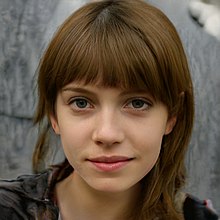StyleGAN

StyleGAN is a novel generative adversarial network (GAN) introduced by Nvidia researchers in December 2018,[1] and made source available in February 2019.[2][3]
StyleGAN depends on Nvidia's CUDA software, GPUs and TensorFlow.[4]
History
In December 2018, Nvidia researchers distributed a preprint with accompanying software introducing StyleGAN, a GAN for producing an unlimited number of (often convincing) portraits of fake human faces. StyleGAN was able to run on Nvidia's commodity GPU processors.
In February 2019, Uber engineer Phillip Wang used the software to create This Person Does Not Exist, which displayed a new face on each web page reload.[5][6] Wang himself has expressed amazement, given that humans are evolved to specifically understand human faces, that nevertheless StyleGAN can competitively "pick apart all the relevant features (of human faces) and recompose them in a way that's coherent."[7]
In September 2019, a website called Generated Photos published 100,000 images as a collection of stock photos.[8] The collection was made using a private dataset shot a controlled environment with similar light and angles.[9]
Similarly, two faculty at the University of Washington's Information School used StyleGAN to create Which Face is Real?, which challenged visitors to differentiate between a fake and a real face side-by-side.[6] The faculty stated the intention was to "educate the public" about the existence of this technology so they could be wary of it, "just like eventually most people were made aware that you can Photoshop an image".[10]
The second version of StyleGAN, called StyleGAN2, is published on 5 February 2020. It removes some of the characteristic artifacts and improves the image quality.[11][12]
Related issues
The technology has drawn comparison with deep fakes[13] and its potential usage for sinister purposes has been bruited.
In December 2019, Facebook took down a network of accounts with false identities, and mentioned that some of them had used profile pictures created with artificial intelligence.[14]
References
- ^ "GAN 2.0: NVIDIA's Hyperrealistic Face Generator". SyncedReview.com. 2018-12-14. Retrieved 2019-10-03.
- ^ "NVIDIA Open-Sources Hyper-Realistic Face Generator StyleGAN". Medium.com. 2019-02-09. Retrieved 2019-10-03.
- ^ Beschizza, Rob (2019-02-15). "This Person Does Not Exist". Boing-Boing. Retrieved 2019-02-16.
- ^ Larabel, Michael (2019-02-10). "NVIDIA Opens Up The Code To StyleGAN - Create Your Own AI Family Portraits". Phoronix.com. Retrieved 2019-10-03.
- ^ msmash, n/a (2019-02-14). "'This Person Does Not Exist' Website Uses AI To Create Realistic Yet Horrifying Faces". Slashdot. Retrieved 2019-02-16.
- ^ a b Fleishman, Glenn (30 April 2019). "How to spot the realistic fake people creeping into your timelines". Fast Company. Retrieved 7 June 2020.
- ^ Bishop, Katie (7 February 2020). "AI in the adult industry: porn may soon feature people who don't exist". The Guardian. Retrieved 8 June 2020.
- ^ Porter, Jon (2019-09-20). "100,000 free AI-generated headshots put stock photo companies on notice". The Verge. Retrieved 2020-08-04.
- ^ Timmins, Jane Wakefield and Beth (2020-02-29). "Could deepfakes be used to train office workers?". BBC News. Retrieved 2020-08-04.
- ^ Vincent, James (3 March 2019). "Can you tell the difference between a real face and an AI-generated fake?". The Verge. Retrieved 8 June 2020.
- ^ "Synthesizing High-Resolution Images with StyleGAN2 – NVIDIA Developer News Center". news.developer.nvidia.com. Retrieved 2020-08-11.
- ^ NVlabs/stylegan2, NVIDIA Research Projects, 2020-08-11, retrieved 2020-08-11
- ^ Paez, Danny (2019-02-13). "This Person Does Not Exist Is the Best One-Off Website of 2019". Inverse (website). Retrieved 2019-02-16.
- ^ News, A. B. C. "Facebook's latest takedown has a twist -- AI-generated profile pictures". ABC News. Retrieved 2020-08-04.
{{cite web}}:|last=has generic name (help)
See also
External links
- The original 2018 Nvidia StyleGAN paper 'A Style-Based Generator Architecture for Generative Adversarial Networks' at arXiv.org
- StyleGAN code at GitHub.com
- This Person Does Not Exist
